Chapter 1. LAB 12 Laboratory Skills 4: Competency Exam
Introduction
Learning Goals
- Demonstrate an acceptable level of mastery for use of the spectrophotometer, compound microscope, balance, micropipettes, pH meter, and Vernier caliper, reliably, safely, and accurately
- Use a checklist of predefined criteria to learn to recognize when someone else is using a piece of equipment correctly
Lab Outline
Part 2: Peer Assess Tool-Use Proficiency
Part 3: Take the Competency Exam
1.1 Background
Tools are important in laboratory research and they must be used correctly to avoid mistakes that result in incorrect measurements, or damage to the tool, the user, or the lab.
In a previous lab, you learned the SALI strategy that trained you to approach new instrumentation in a well-defined, formal way to maximize accuracy and safety in the use of new instrumentation. This is a skill you develop with practice over time where your knowledge, coordination, and reflexes become integrated to make you a skilled tool user. Specialists including surgeons, electricians, and plumbers spend years learning to use the specialized tools that they need to master their professions. Even when learning how to drive, one must pass both a written exam to evaluate how well they know the “rules of the road,” and a road test to evaluate how competent they are when actually driving a vehicle.
The tools you were trained to use in all of the previous labs are standard pieces of laboratory instrumentation in biology research. Even if you encounter a more modern version of one of these tools in someone’s lab, the measurements and principles underlying their use will probably be the same. Importantly, there will always be a standardized protocol (standard operating procedure, or SOP) for the correct use of the tool for the sake of safety, cost, and accuracy.
The Competency Exam is designed to insure that you have internalized and can apply the rules for correct use of: 1) the compound microscope, 2) spectrophotometer, 3) Vernier caliper, 4) centrifuge, 5) micropipette, 6) digital balance, and 7) pH meter. In preparation you should have completed a Strategic Approach to Laboratory Instrumentation (SALI) for each piece of equipment used in the introductory biology labs. You should have referenced your SALIs for each lab in which you used these instruments. The week before the Competency Exam, you should review these pieces of equipment in the Biology Learning Center. The table of “instrumentation competency topics” (Table 1) lists skills to develop as you practice using each piece of lab equipment.
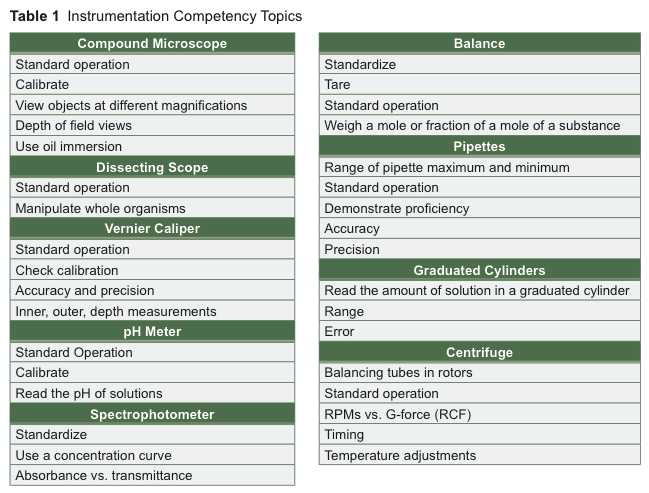
Keep a record of your skill or competency assessments.
1.2 Exam Preparation
Exam Preparation
Complete Parts 1 and 2 prior to the exam.
1.3 Part 1: Practice, Practice, Practice (prior to the exam)
Purpose
Visit the Biology Learning Center the week before the Competency Exam to review and practice use of lab equipment. Practice is a key element in the learning of a new tool as stated by the SALI, but practice alone is not sufficient. You need an expert to critique your technique or “criteria” with a checklist to follow so that you know whether or not your technique meets expected standards. For example, if you do not know how to blank the spectrophotometer correctly, what impact will that have on the accuracy of the absorbance reading for your solution?
Learning Objectives
After successful completion of this activity, you should be able to
LO63 Focus a prepared tissue slide under a compound microscope at 400× magnification with good resolution and good illumination, and count the number of cells in the field of view
LO63 Standardize a pH meter with three standard pH solutions and measure the pH of an unknown solution
LO15 Accurately weigh solids and liquids on a balance
LO15 Balance an even or odd number of tubes in a microcentrifuge
LO15 Measure an object with Vernier calipers to 1/10th of a millimeter
LO15 Demonstrate how to avoid damage to a micropipette
LO15 Use a micropipette to accurately measure specific small volumes of liquid
LO18 Calculate solution dilutions based on ratio, percent (wt per volume), molarity, or concentration
Materials
Competency Exam questions (posted the week before the exam)
Part 1 Procedure
- Review Table 1 Instrumentation Competency Topics and the SALIs that your group members prepared for the Tool Use Pre-lab. You will be tested on the spectrophotometer, microcentrifuge, compound microscope, pH meter, micropipette, balance, microcentrifuge, and Vernier caliper.
- Create a chart in your lab notebook similar to Table 2 Instrumentation Competency Self-Assessment Table. Test your knowledge of the tool by making a checklist from memory of the standard operating procedure (SOP) for the instrument and important safety issues. SOPs are common in labs or industry and denote the standard protocol used to operate any tool for a specific purpose.
- You should already have an SOP as part of the “Safety” section of the SALI. Refine your SOP as a checklist of items you perform to make sure each component of the instrument is set up to obtain the best information from the tool. Use the online videos of the tools to help you check the completeness of your SOP.
- If you cannot produce an SOP from memory, you should not touch any instruments until you are able to recall the SOP for the tool because you do not have the knowledge or skill required to safely use the instrument.
- Once you have produced your SOP checklist, you may ask an instructor to scrutinize your list for its accuracy. This is your opportunity to resolve any questions you have about the tools.
- Come to the BLC regularly to practice with each piece of equipment and make note of any important safety, use, or accuracy issues associated with each instrument. Try developing analogies that aid you in remembering how to standardize the piece of equipment, collect data, or record measurements with it and the rationale for the process.
- By the time you actually have to use an instrument in an actual lab activity you should be confident that you know each instrument, its parts and their function, the order in which to approach the instrument based on an SOP and your ability to produce reproducible results, and have the coordination and dexterity to use the instrument correctly.
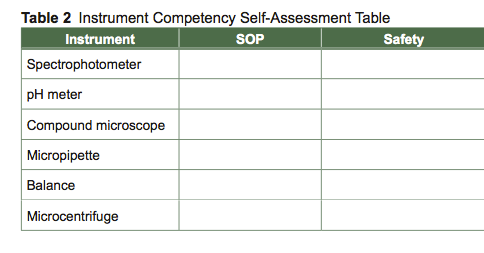
1.4 Part 2: Peer Assess Tool-Use Proficiency (prior to the exam)
The following checklists are similar to the actual examiner checklists used to evaluate your skill with a given piece of equipment. Use these checklists to test whether other students are able to use the equipment correctly within 5 minutes. Testing each other is very effective preparation for the exam and allows you to assess and improve your general skill level. If you need further help refer to Appendix B for information on mastery level and proper use of lab equipment.
Materials
Competency Exam questions (posted the week before the exam)
Equipment checklist
Peer examiner (a student in the course)
Learning Objectives
After successful completion of this activity, you should be able to
Complete the LOs from Part 1
Part 2 Procedure
- Select a piece of equipment to be tested on by another student peer.
- Give the student assessor a copy of the equipment checklist. Assign points to each item under the piece of equipment of interest to produce a scoring rubric.
- Set the timer for 5 minutes and complete the competency practice station once the peer starts the timer. The peer examiner should announce when you have 3 minutes and 1 minute left to your time.
- Stop immediately when the timer beeps. Your peer will sum your points and give you your score. You can also request their feedback on what you did well or poorly on.
- Determine your demonstrated skill level (Appendix B) based on your score and the peer feedback.
- Repeat the peer assessment process as often as needed until you are confident about your ability to use each piece of equipment.
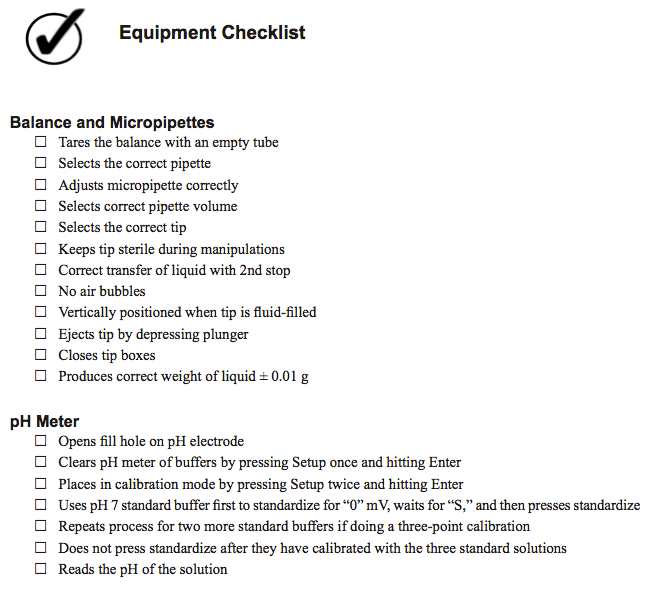
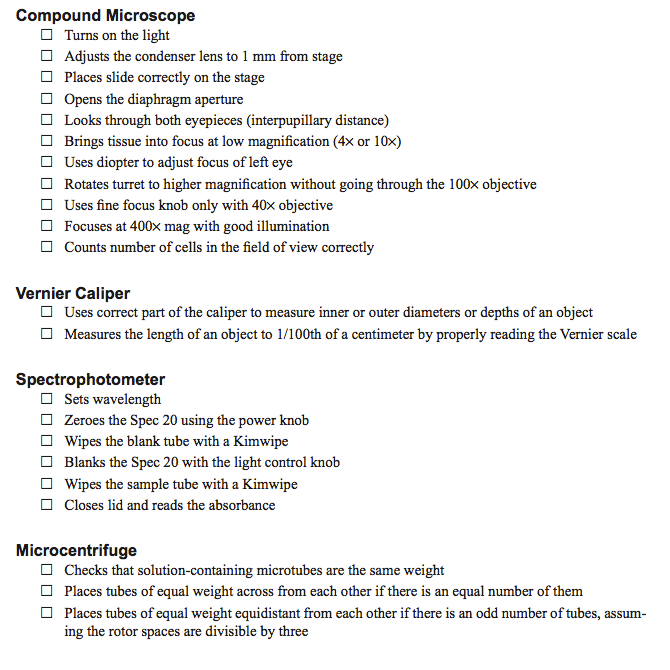
1.5 Part 3: Take the Competency Exam
Purpose
The purpose of the competency exam is to test your mastery level of the equipment used in lab. Since participation in a biology lab requires the proper use of tools each week, and these skills are further developed in upper division labs, it is critical to assess the degree to which you have acquired these skills from novice to expert level.
The competency exam will take place at several stations. Each station will be administered by an examiner who will observe you “one on one” as you seek to safely and accurately complete the task at hand using the proper equipment. Each of the tasks are posted in the Biology Learning Center and on the course website prior to the examination so that you will know what to expect before the exam and can focus on completion of the task in the limited 5 minutes you are provided at each station.
The exam itself will be conducted according to the following procedure.
Materials
SBU ID
Blue or black ink pen
The following items are not allowed: notes, calculators, and electronic devices
Part 3 Procedure
- Arrive to the competency exam room at least 5–10 minutes before your scheduled time. If there are time slots open, you may be allowed to take the exam before your scheduled time.
- Sign the competency exam sign-in sheet for your section. This sign-in sheet will be provided to your instructor as verification of your attendance at the exam.
- Sit in the waiting room until you are called to start the exam.
- Once you are seated in the exam area, you will be handed an answer sheet. Complete the top of the answer sheet in blue or black ink with your name, SBU ID#, date, and time.
- Read through the answer sheet to familiarize yourself with the tasks for each station of the competency exam. Note the positions on the exam where you will be required to write answers and where your examiner will write in values or scores.
- Once you enter station 1, your examiner will use a checklist (similar to the instrument checklist in Part 2) to note which steps you complete properly, do not complete, or complete improperly. You will have 5 minutes to complete station 1 and will receive a grade at the end of the 5 minutes on your performance. If the equipment malfunctions during the exam, immediately bring this to your examiner’s attention. Do not wait until the exam is over when nothing can be done about the situation.
- You will proceed to station 2 as soon as the timer buzzes and will start station 2 immediately. Students who are adequately prepared, i.e., they have practiced each instrument throughout the semester, will be able to complete most stations in 3–4 minutes, although they receive 5 minutes.
- You will continue the rotation process until you have completed all of the stations.
- After the last station you will hand in your answer sheet and show your SBU ID, at which time you will be free to leave.
- Your exam will be tallied and you will receive your score on the course website. You will have an opportunity to check your exam against the examiner key for grading discrepancies or point disputes.
Competency Exam
Complete Stations 1, either 2A or 2B, and 3 for a total of 50 points. Prepare for all stations since you will be randomly assigned to either 2A or 2B.
Station #1 (5 mins, 20 pts): Micropipettes and Balance
(Directions will not be posted during the exam)
Pipette (volume between 1–1000) μl into an eppendorf tube AND determine the weight of that volume of solution.
Station #2A (5 mins, 20 pts): Compound Microscope
(Directions will not be posted during the exam)
Focus the tissue at (between 1.5–400) × total magnification. Examiner will check evenness of illumination and focus. Estimate and record the approximate (number of items or cells) in your field of view.
Station #2B (5 mins, 20 pts): Spectrophotometer and Dilutions
(Directions will not be posted during the exam)
How would you make (a volume) ml of (a ratio) dilution? Record the volume of stock solution and the volume of water AND measure the absorbance of the solution at (wavelength between 400–650) nm.
Station #3 (5 mins, 10 pts): Microcentrifuge and Vernier Caliper
(Directions will not be posted during the exam)
Observe and determine the answers to Vernier caliper and centrifuge schematic questions. Write the answer in the box provided. The tools are provided for visual aid.
1.6 Examiner’s Key to Station #1 (5 mins, 20 pts)
INSTRUCTIONS
- Show the student the posted question: “Pipette ____ into an eppendorf tube AND determine the weight of that volume of solution.”
- State clearly to the student: “The balance is plugged in and calibrated.”
- Do not give them help with any procedure except if they are breaking the pipettor.
- Write your score in the box next to the question. If you make a mistake, do not cross out your score. You must transfer the information to another answer sheet.
- If student presses CALIBRATE on the balance, turn balance off and back on to reset.
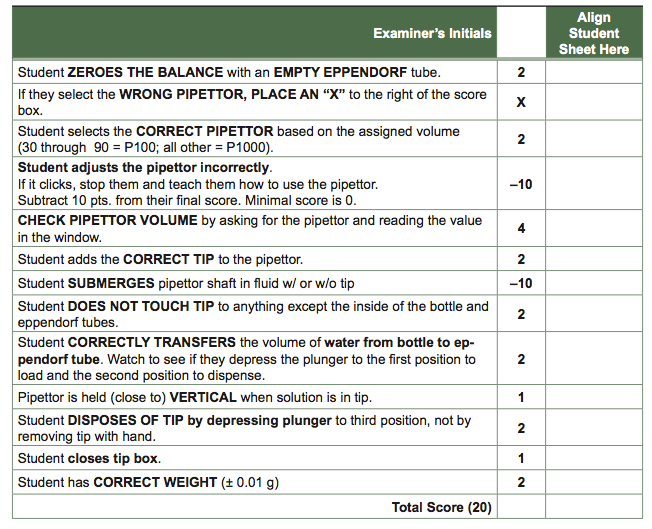
RESET the STATION:
- Remove any autoclave tape from the pipette tip boxes.
- Check number of tips and water. Empty tip and tube waste into regular trash.
- Dry balance if necessary.
- Set pipettors to 5, 50, and 500 μl.
1.7 Examiner’s Key to Station #2A (5 mins, 20 pts)
INSTRUCTIONS
- Draw a line through the score boxes for station #2B on the student’s answer sheet.
- Show the student the posted question: “Focus the tissue at 400× total magnification.”
- Do not help with the tool use. Remind students that the number of cells should be estimated, not precisely counted.
- Write your score in the box next to the question on the student answer sheet. If you make a mistake, do not cross out your score. You must transfer the information to another answer sheet.
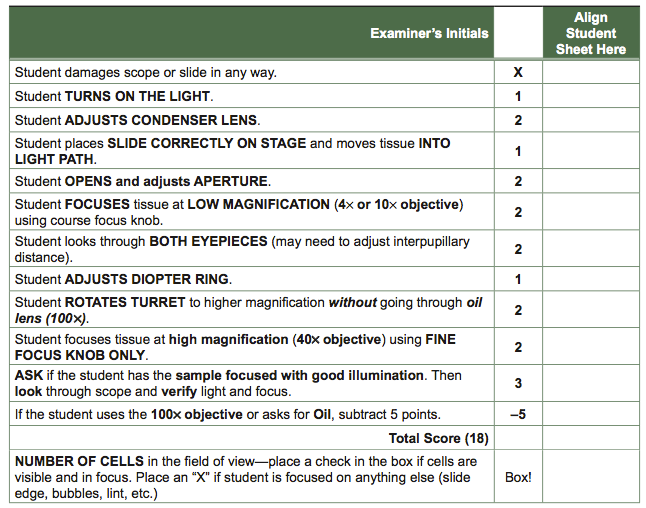
RESET the STATION:
- Rotate turret to low magnification (4× objective) as follows: 40×→10×→4× (not through the 100×)!
- Lower stage to bottom by turning coarse focus knob towards you.
- Close diaphragm aperture.
- Lower condenser lens to bottom.
- Rotate diopter ring.
- Turn off light.
- Place slide on counter. If scope or slide is dirty, clean with lens paper and Windex.
1.8 Examiner’s Key to Station #2B (5 mins, 20 pts)
INSTRUCTIONS
- Draw a line through the score boxes for station #2A on the student’s answer sheet.
- Show the student the posted question: “How would you make _____ ml of a 1:10 dilution? Record the volume of stock solution and the volume of water AND measure the absorbance of the solution at 550 nm.”
- State clearly to the student: “The Spec 20 is on and warmed up.”
- Tell the student which tube is the blank and which of the tubes (A–J) to use to measure absorbance. Write the letter (A–J) on their answer sheet next to Tube.
- Check to be sure that the student records both the volume of the stock and the volume of the water.
- Do not help with any calculation or answer any question about the problem. You may remind them of the remaining time.
- Write your score in the box next to the question on the student answer sheet. If you make a mistake, do not cross out your score. You must transfer the information to another answer sheet.
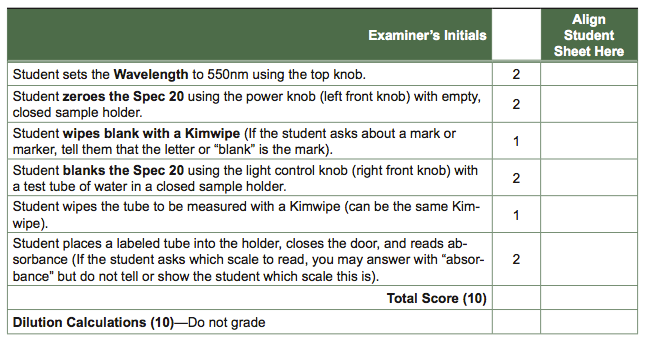
RESET the STATION:
- Set the wavelength to 600 nm and turn the left knob a little to the left.
- Make sure that the Spec 20 is on.
- Make sure that the tubes are in order and blank is to the far right.
- Check for Kimwipes. Restock station from front bench.